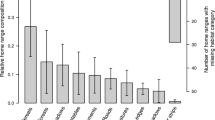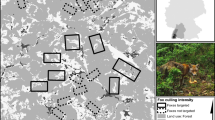Abstract
A recent European animal welfare recommendation stresses the importance of studying digging behaviour in farm-born blue foxes (Alopex lagopus). The current study was conducted (1) to clarify the extent of digging and (2) to evaluate factors that motivate digging. In experiment 1, six juvenile male blue foxes were housed together from August to the following June in an earthen enclosure. Experiment 2 was conducted from July to December, using ten enclosures each containing two juvenile male blue foxes. Behaviour was monitored by 24-h video recordings and visual observations. Progress of digging was also followed by making scale drawings of all digging marks on paper. As early as the first study day, clear signs of digging were observed. Digging sites were concentrated below and close to nestboxes and pen walls. Maximally about 20% of the total enclosure area was affected. The total surface area of digging sites did not increase from late summer onwards because foxes tended simultaneously to cover part of the old sites when digging new ones. Motivational tendency to dig varied with time. Digging activity decreased during autumn and almost totally ceased during winter. In May, foxes resumed digging activity. Digging motivation was evaluated by two means: (1) by analyzing digging purpose (experiments 1 and 2), and (2) by the damming-up test (experiment 1), that is, after 10 months foxes that had been exposed to the earthen floor were transferred for 12 days into wire-mesh cages with no possibility to dig in the ground. Thereafter, foxes were transferred back into the earthen enclosure to measure the rebound of digging following deprivation. Foxes were observed to dig for the following reasons: (1) to make a hole or a resting site, (2) to locate an escape route, (3) to cache food, faeces, or sticks, (4) in response to a novel object (new nestbox, replacement of nestbox), and (5) displacement without any clear goal. Daily time spent digging averaged 7 min and 17 min per fox in Exps. 1 and 2, respectively. A clear rebound effect for digging was not identified. It can be concluded that digging is a complex behavioural pattern caused by a variety of motivations that can vary over time. The present study was unable to show unambiguously that digging is an important need for farmed foxes.
Similar content being viewed by others
Author information
Authors and Affiliations
Additional information
Received: 28 February 2000 / Received in revised form: 6 June 2000 / Accepted: 20 June 2000
Rights and permissions
About this article
Cite this article
Korhonen, H., Niemelä, P. & Wikman, I. Extent of digging and its possible underlying causal factors in penned blue foxes. acta ethol 3, 127–133 (2001). https://doi.org/10.1007/s102110000033
Issue Date:
DOI: https://doi.org/10.1007/s102110000033




